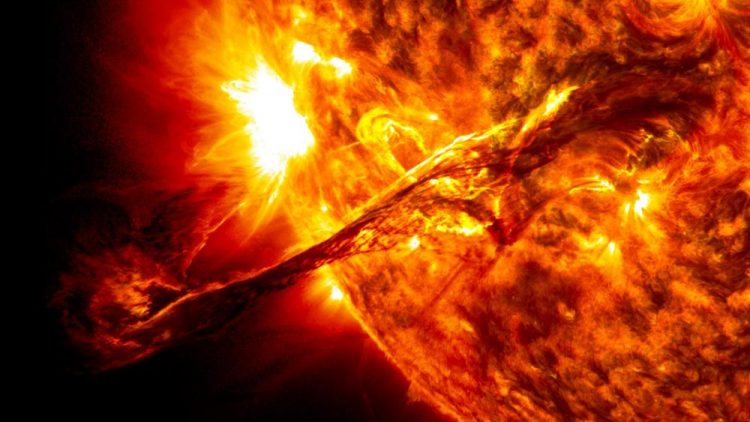Flares in the universe can now be studied on Earth

Solar flares are caused by magnetic reconnection in space and can interfere with our communications satellites, affecting power grids, air traffic and telephony. Now, researchers at Chalmers University of Technology, Sweden, have found a new way to imitate and study these spectacular space plasma phenomena in a laboratory environment. Credit: NASA/SDO/AIA/Goddard Space Flight Center
Now, physicists at Chalmers University of Technology, Sweden, have discovered a new way to study these spectacular space plasma phenomena in a laboratory environment. The results have been published in the renowned journal Nature Communications.
“Scientists have been trying to bring these space phenomena down to earth for a decade. With our new method we can enter a new era, and investigate what was previously impossible to study. It will tell us more about how these events occur,” says Longqing Yi, researcher at the Department of Physics at Chalmers.
The research concerns so-called 'magnetic reconnection' – the process which gives rise to these phenomena. Magnetic reconnection causes sudden conversion of energy stored in the magnetic field into heat and kinetic energy.
This happens when two plasmas with anti-parallel magnetic fields are pushed together, and the magnetic field lines converge and reconnect. This interaction leads to violently accelerated plasma particles that can sometimes be seen with the naked eye – for example, during the northern lights.
Magnetic reconnection in space can also influence us on earth. The creation of solar flares can interfere with communications satellites, and thus affect power grids, air traffic and telephony.
In order to imitate and study these spectacular space plasma phenomena in the laboratory, you need a high-power laser, to create magnetic fields around a million times stronger than those found on the surface of the sun. In the new scientific article, Longqing Yi, along with Professor Tünde Fülöp from the Department of Physics, proposed an experiment in which magnetic reconnection can be studied in a new, more precise way.
Through the use of grazing incidence of ultra-short laser pulses, the effect can be achieved without overheating the plasma. The process can thus be studied very cleanly, without the laser directly affecting the internal energy of the plasma.
The proposed experiment would therefore allow us to seek answers to some of the most fundamental questions in astrophysics.
“We hope that this can inspire many research groups to use our results. This is a great opportunity to look for knowledge that could be useful in a number of areas. For example, we need to better understand solar flares, which can interfere with important communication systems. We also need to be able to control the instabilities caused by magnetic reconnection in fusion devices,” says Tünde Fülöp.
The study on which the new results are based was financed by the Knut and Alice Wallenberg foundation, through the framework of the project 'Plasma-based Compact Ion Sources', and the ERC project 'Running away and radiating'.
Media Contact
More Information:
http://dx.doi.org/10.1038/s41467-018-04065-3All latest news from the category: Physics and Astronomy
This area deals with the fundamental laws and building blocks of nature and how they interact, the properties and the behavior of matter, and research into space and time and their structures.
innovations-report provides in-depth reports and articles on subjects such as astrophysics, laser technologies, nuclear, quantum, particle and solid-state physics, nanotechnologies, planetary research and findings (Mars, Venus) and developments related to the Hubble Telescope.
Newest articles

NASA: Mystery of life’s handedness deepens
The mystery of why life uses molecules with specific orientations has deepened with a NASA-funded discovery that RNA — a key molecule thought to have potentially held the instructions for…

What are the effects of historic lithium mining on water quality?
Study reveals low levels of common contaminants but high levels of other elements in waters associated with an abandoned lithium mine. Lithium ore and mining waste from a historic lithium…

Quantum-inspired design boosts efficiency of heat-to-electricity conversion
Rice engineers take unconventional route to improving thermophotovoltaic systems. Researchers at Rice University have found a new way to improve a key element of thermophotovoltaic (TPV) systems, which convert heat…



